 Welcome to Sonic Buster 8 home page!
Welcome to Sonic Buster 8 home page!
Stock status:
 (20-07-2025) IN STOCK !
(20-07-2025) IN STOCK !
 Please drop me an e-mail to eugenetongue@gmail.com to place an order.
Please drop me an e-mail to eugenetongue@gmail.com to place an order.
 Sonic Buster 8 review on YouTube by root42
Sonic Buster 8 review on YouTube by root42
Sonic Buster 8 review on Retronautics by appiah4
Sonic Buster 8 thread on VOGONS.ORG
Latest firmware version is 4.01
 Overview
Overview
 Features
Features
 Configuration
Configuration
 PC-Speaker input
PC-Speaker input
 CD/Aux audio input
CD/Aux audio input
 Volume controls
Volume controls
 Audio output
Audio output
 Firmware updates
Firmware updates
 New DSP functions
New DSP functions
 Photo gallery
Photo gallery
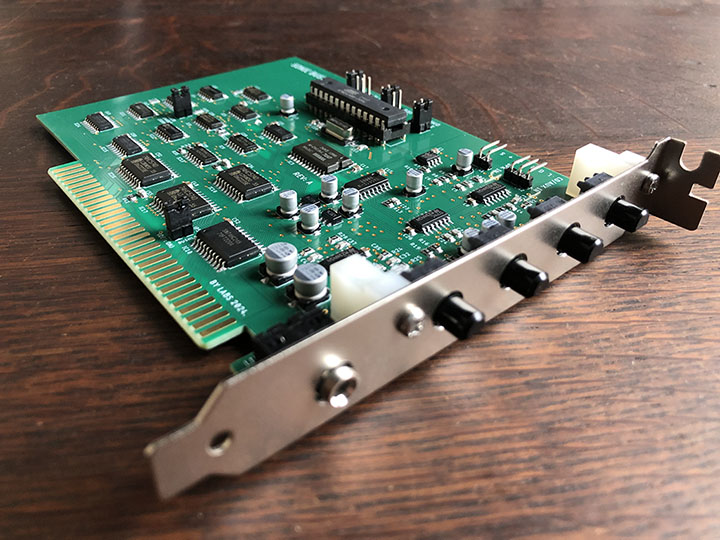
Sonic Buster 8 is a modern ISA sound card for PC XT (8086) / AT (286, 386, 486, Pentium) or compatible computers intended for retro-gaming in DOS and early Windows environments. The card is simple to use and is fully compatible with the most supported card in DOS - Sound Blaster 2.0. Its firmware is based on a reverse-engineered SB2.0 firmware and is written entirely from scratch for the AVR MCU, implementing all internal workings of the original card. But being fully playback-compatible with Sound Blaster 2.0, Sonic Buster 8 also surpasses it in many ways.
The card intergrates a high quality ultra-quiet analog path, which drastically reduces background noise (which Sound Blaster is famous for) to a level of non-existing. It also uses 2-stage active filtering for minimizing aliasing effects of a 8-bit sound while trying to keep the high frequences in place. All this results in a much cleaner and pronounced sound.
For games with CD music Sonic Blaster 8 has an internal stereo CD/Aux input with a dedicated volume control on the back panel. It can also be used for connecting any line-level sound source like a MIDI sound module or an output from another sound card for example.
For very old games which support PC-Speaker sound, Sonic Buster 8 has a PC-Speaker input with a dedicated volume control on the back panel and an active filter in the audio path, which tries very hard to make PC-Speaker sound a bit more pleasant.
Unlike Sound Blaster, Sonic Buster 8 has an analog audio mixer with four dedicated volume control pots for all its sound sources - PCM/ADPCM audio, FM music, CD/Aux and PC-Speaker.
And finally it uses a better version of OPL2 chip - an OPL3 for FM music playback.
-
Fully compatible with Sound Blaster 2.0 8-bit mono PCM and ADPCM digital audio playback. PCM playback rate up to 62500Hz. Offers new SB8-specific DSP functions for future retro software.
-
Using OPL3 FM chip instead of OPL2 for FM music playback. OPL3 is fully compatible with OPL2 and sounds the same, but can play more advanced music in games that support OPL3 and also has way less timing issues with games running computers faster than a 386.
-
CD/Aux stereo input for connecting CD-ROM audio or any other sound source like a MIDI sound module for example.
-
PC-Speaker input for routing beeper sounds to the audio output of the card instead of an internal computer speaker. For the most ancient games.
-
Super quiet (around -100dB RMS) analog audio path = no more Sound Blaster background noise from the speakers.
-
Firmware is upgradable from DOS.
-
Works on systems which does not have a 14.32MHz clock on ISA bus, which was a problem for the original Sound Blaster that required it.
-
Doesn’t need a -5V power rail to operate, as some PSUs do not provide it. -5V rail was a requirement for the original Sound Blaster.
-
Works with 6/8/12MHz ISA bus speeds.
-
An ability to disable Adlib functionality for port 388h by removing JP4.
Configuration
System requirements 
IBM PC XT / AT 286, 386, 486 or Pentium with one free 8/16-bit ISA slot.
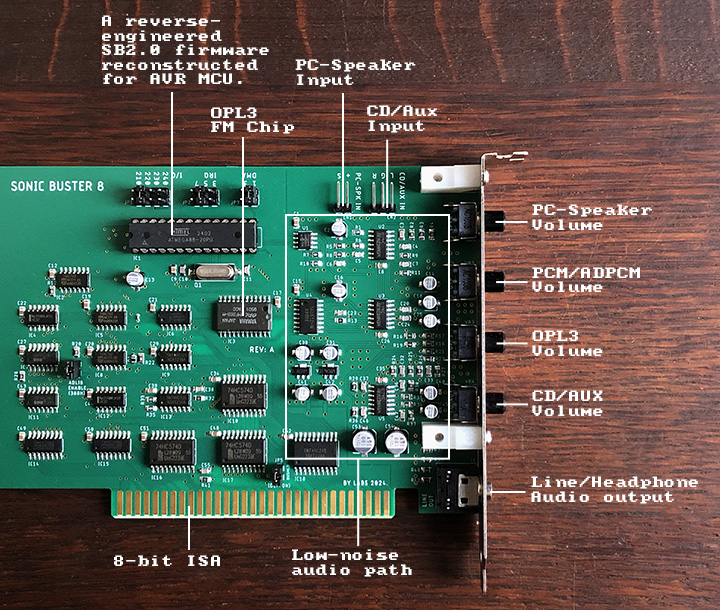
Hardware settings
Hardware configuration is made by selecting I/O port, IRQ and DMA with JP1, JP2 and JP3 jumpers respectively. Make sure the computer is switched off before adjusting the settings.
The most common configuration is 220h for I/O port, 5 for IRQ and 1 for DMA:
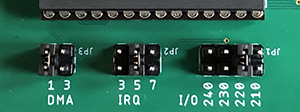
DMACTL jumper
This jumper is used to enable or disable sharing of the selected DMA channel (JP2) with the rest of the system. It is here just for compatibility with SB 2.0 settings and should remain in its default state unless you need to share the DMA channel, which is very unlikely and not recommended.
| JP4 | |
|---|---|
| 1-2 | DMA sharing is disabled (default) |
| 2-3 | DMA sharing is enabled |
This jumper is not present on REV-A boards.
ADLIBEN (Adlib enable) jumper
This feature was requested by several users who also have an Adlib card installed on the same machine and want it to play FM music instead of Sonic Buster 8 when “Adlib (388h)” is selected as a music device in game setup.
| JP5 | |
|---|---|
| CLOSE | Port 388h is activated (default) |
| OPEN | Port 388h is inactive |
This jumper should remain closed for normal operation.
When this jumper is opened, an OPL3 chip will be disconnected from Adlib port (388h), but will keep working on 2x0h-2x3h and 2x8h/2x9h ports.
This jumper is JP4 on REV-A boards.
RESET jumper
This jumper is used to select the card’s reset mode.
By default, Sonic Buster 8 is designed to be way more tolerant to machines faster than a low-end 486 as compared to the original SB 2.0 card. Some particular software can successfully work with Sonic Buster 8 on systems where SB 2.0 has no chances at all (for example a Crystal demo, Prince of Persia, Alone In The Dark in DMA mode and others). But Sonic Buster 8 also has an alternative reset circuit to experiment with.
| JP6 | |
|---|---|
| 1-2 | SB 2.0 reset mode (default) |
| 2-3 | IORDY reset mode |
It is recommened to keep it in SB 2.0 reset mode by default. But if you want to experiment with any problematic software - try setting it to IORDY mode and see how it will behave on your particular system. Please note that this mode is not compatible with everything. It was reported that the game Gods does not produce PCM sound when IORDY reset mode is selected, but Build engine games like Duke Nukem 3D, Blood, Redneck Rampage and others startup faster in this mode than with the original SB 2.0 card.
On REV-A cards it is a 2-pin jumper named BUSHLD:
| JP5 | |
|---|---|
| OPEN | SB 2.0 reset mode (default) |
| CLOSE | IORDY reset mode |
DOS configuration
In order to tell DOS software which settings are selected, it is necessary to set a BLASTER environment variable with corresponding parameters. This is done by adding a string to C:\AUTOEXEC.BAT. For the hardware settings pictured above the string is:
SET BLASTER = A220 I5 D1 T3
Where:
Axxx – I/O address (210/220/230/240)
Dx – 8-bit DMA setting (1/3)
Ix – IRQ number (3/5/7)
Tx – Sound Blaster model, where 3 is for SB 2.0 as well as for Sonic Buster 8
These parameters will take effect only after system reboot.
Games configuration
In order to use Sonic Buster 8 in games just configure it as a Sound Blaster version 2.0 or earlier.
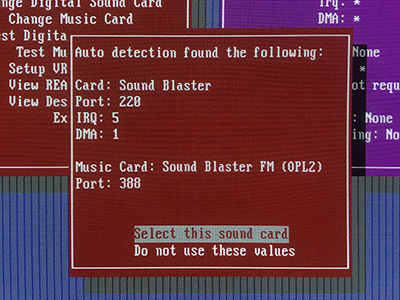
Although Music Card was automatically set to Sound Blaster FM (OPL2), for advanced music it can be manually changed to OPL3 if the game supports it:
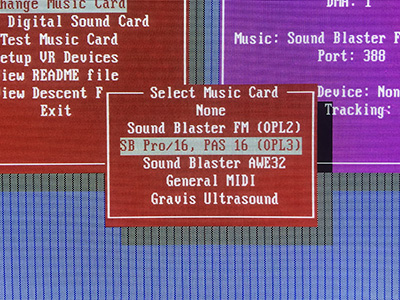
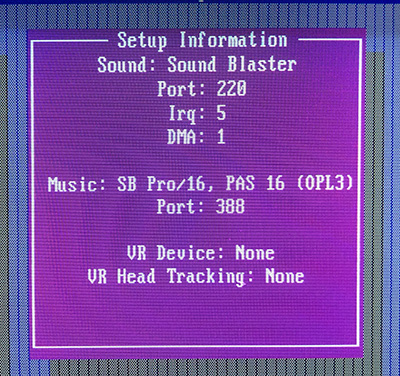
Windows 9x/ME configuration
Windows 9x/ME detects Sonic Buster 8 as a Sound Blaster or compatible during OS installation or after running Control Panel -> Add New Hardware wizard:
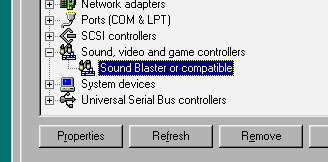
 PC-Speaker input
PC-Speaker input
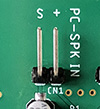
This input was added for very old games that does not support any sound device except the PC-Speaker. Its audio path has an active low-pass filter to round up the beeper waveform a bit and make it a little more pleasant to the ears.
A signal from the motherboard should be connected to this input. A 4-pin header on the motherboard is usually marked as SPK or SPEAKER, but only the two pins on the connector ends matter. One of them is usually named VCC or SPEAK+ or just +, while the other one can be something like SPEAK- or not marked at all. Use the included 2-pin cable to connect the first one to + pin on the card and the other one to S pin.
If there is no speaker signal present at the output, please check its gain setting on the back panel of the card or try swapping the connected pins.
This input accepts only PC-Speaker signal and is not intended for other audio sources.
 CD/Aux input
CD/Aux input

This input accepts a line-level stereo signal. Left, ground and right pins are marked as L, G and R. Use the included 3-pin cable to connect analog audio output of a CD-ROM to this input. It can also be used for any other audio source, for example a MIDI sound module or an output of another sound card in the system. The gain can be adjusted with a corresponding volume pot on the back panel of the card.
Manual volume controls
There are four volume pots on the back panel of the card for adjusting volume levels of PCM/ADPCM audio, FM music, PC-Speaker and CD/Aux:

When the card’s output is connected to an amplifier or active speakers it is recommended to set OPL3 level to maximum (clockwise) and adjust other levels accordingly to your liking, as OPL3 has the widest dynamic range and can seem to be more quiet that the others.
Audio output
The card’s analog mixer provides a low-noise audio output that accepts standard stereo mini-jack connection and can be fed to an amplified sound system or directly to headphones.
CAUTION: Using headphones with excessive volume levels can damage your ears!
Firmware updates
Latest firmware version is 4.01
Download  SB8VER.ZIP utility to check if your Sonic Buster 8 firmware is up to date.
SB8VER.ZIP utility to check if your Sonic Buster 8 firmware is up to date.
The update utility should NOT be run from Windows multi-tasking environment! Also make sure that no other programs are using Sonic Buster 8 hardware during the update when running it from DOS!

 SB8FW401.ZIP - Sonic Buster 8 firmware v4.01.
SB8FW401.ZIP - Sonic Buster 8 firmware v4.01.
This update fixes DMA timing issues on some machines and is recommended for all Sonic Buster 8 users.
Download the archive, extract to a separate directory and run SB8FLASH.EXE. Follow on-screen instructions to make an update.
New DSP functions
For those who is developing new software for DOS and want to support Sonic Buster 8 features here is a description of new DSP functions that Sonic Buster 8 adds to the Sound Blaster command set.
Detecting Sonic Buster 8
Command E5h is used to read Sonic Buster 8 firmware version.
Output: E5h
Remarks: After sending this command, read back two bytes from the DSP. The first byte is the major version number and the second byte is the minor version number. For Sonic Buster 8 the major version number is always 4, while minor version is variable.
If reading bytes from the DSP was successfull it means that Sonic Buster 8 is present in the system and its features like an OPL3 FM chip and other specific DSP functions can be utilized by the program.
If reading bytes from the DSP has failed (timed out) it means that Sonic Buster 8 card is not present in the system.
Setting 16-bit time constant
Thanks to the 16-bit timer, Sonic Buster 8 allows to set 16-bit time constant for more accurate DSP playback rate.
The process of setting the time constant is simple:
- Read a value from the DSP with command 50h
- Make calculations
- Write the result to the DSP with command 51h
50h - Read DSP clock constant
Output: 50h
Remarks: After sending this command, read four bytes back from the DSP. These four bytes form a 32-bit value representing the DSP clock speed. The first byte read contains bits 31-24 of the value, the second - bits 23-16, the third - bits 15-8 and finally the last byte contains 7-0 bits of the value.
This 32-bit value is always constant for the exact Sonic Buster 8 card and thus should be read only once during the init. However, it can differ between card models and revisions.
After reading the clock speed, a time constant should now be calculated as follows:
time_constant = dsp_clock_speed / playback_rate
The result should be rounded to the closest 2-byte integer value and sent back to the DSP using command 51h.
Example:
If we need to set playback rate to 44100 Hz
and command 50h returned 14318181
time_constant = 14318181 / 44100
The result is 324.675, which rounds up to 325
A real playback rate of the DSP will be 14318181 / 325 = 44055 Hz
When we set a playback rate of 44100 Hz using command 40h (the Sound Blaster way), the real DSP playback rate will be 45454 Hz, which is way less accurate.
Here is a comparison table for some playback rates set in two different ways:
+--------------------------------------------+
| Requested | Real rate, | Real rate, |
| rate, Hz | cmd 40h, Hz | cmds 50h/51h, Hz |
| --------- | ----------- | ---------------- |
| 11025 | 11111 | 11030 |
| 22050 | 22222 | 22061 |
| 32768 | 33333 | 32764 |
| 44100 | 45454 | 44055 |
+--------------------------------------------+
51h - Write time constant
Output: 51h, time_constant.HighByte, time_constant.LowByte
Remarks: After calculating the time constant using the clock value returned by command 50h, send the two-byte result back to the DSP.
The proper sequence is:
- Send command 51h
- Send time_constant.HighByte
- Send time_constant.LowByte
After this command a DSP playback operation can be initiated.
Photo gallery
REV-B:



REV-A:








Prototype #2:
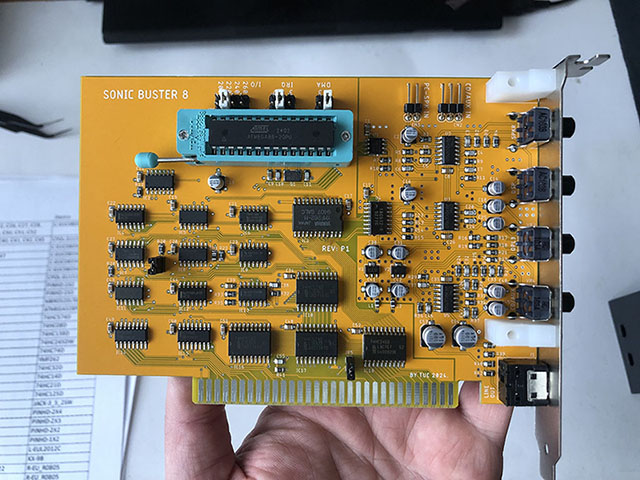
Prototype #1:




